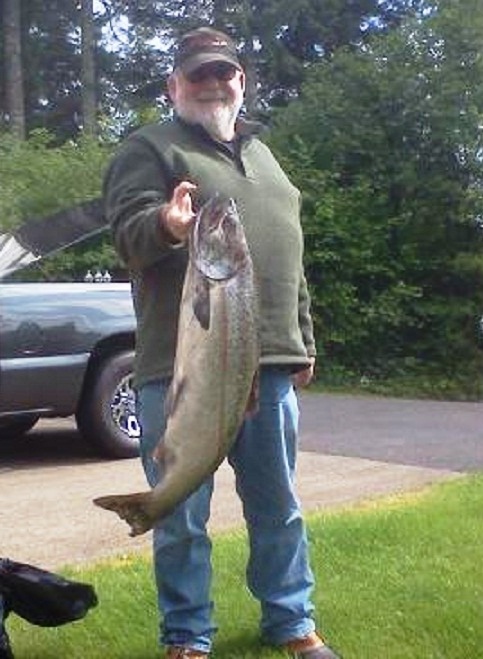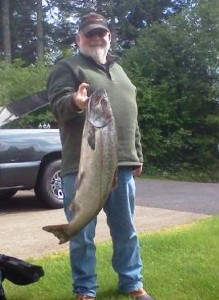Pac NW bests: Salmon!


Saturday, fishing for spring salmon reopened, and I caught a nice 21 lb. hen Chinook. I went with one of my fishing buddies, Custus, to our secret spot on the Columbia and used our secret lures. We hooked four but were able to bring just the one to the net, so the two of us shared it by splitting the fish lengthwise. Loath to waste any of it, we also scraped the little bits of flesh off the bones for sashimi, and then cut off the belly meat and threw that on the BBQ for a snack. And, of course, I sent photos to my brother and Chum, the son-in-law who also fishes, so as to rub in my success.
Chum’s a great guy; he’s originally from the Seattle area. Therefore, he says I was fishing for King salmon. King/Chinook are, of course, the same fish. In northern Washington, British Columbia and Alaska, it’s Kings; in southern Washington, Idaho, Oregon and California, Chinook. Near as I can tell, Chinook salmon become King salmon somewhere around Centralia.
Depending upon the species, I usually prefer to cook salmon on the BBQ. I lay the fish skin-side down on a sheet of aluminum foil, set it on the grill, cover, then wait for the white (yum! Omega-3 fats!) to emerge from the flesh. The fish should be just past translucent. Now slide a spatula under the flesh; the skin will stick to the foil and you can throw all that away. Salt, pepper and some lemon is all one needs to garnish this wonderful treat. We like cold potato salad or maybe some slaw, a steamed veggie and good bread. I’ll cook Chinook, Coho/silver and sockeye this way.
I’ve also poached fish, especially kokanee (the landlocked form of sockeye) as well as other not-so-fat fish. I use our electric skillet, cover the fish with white wine, a little water, some spices and some lemon juice. Then, you can eat it either hot or cold. Cold salmon makes a terrific addition to salads, or mix it with mayo, green onions and maybe some olives as a po-boy; the adventurous will add different cheeses. Add salmon to potatoes, peppers, onions and garlic and make a hash. Or add it to pasta, some pesto and/or chopped parsley, top with parmesan. No other sauces necessary.
I see Copper River salmon started appearing in good fish markets about mid-May this year. Alaska’s Copper River produces both Chinook and sockeye, and because of the high fat content, it’s considered some of the best. And it is. Before you blanch at the $30+/lb. price tag, I figure the salmon I caught Saturday cost conservatively around $2500/lb, factoring in owning too many lures, tackle boxes, fishing poles, outdoor clothes, and all that other “essential stuff.” Plus, there were all those futile non-catching trips. So get yours at the supermarket and enjoy it guilt-free.
I know you already knew this, but a word about the salmon life cycle. Depending upon the species, salmon hatch in fresh water streams as far away as the upper reaches of Idaho’s Snake and Salmon rivers/tributaries. They spend up to 12-24 months in fresh water, then migrate down to the Pacific Ocean for 2 to 4 years, where they pack on the pounds. Then, they come back to their birth river as adults, spawn, and die (their rotted flesh helps feed their new babies… aww… isn’t that cute?!). These are classified as wild salmon, and are usually not allowed to be caught.
Hatchery fish are those who were born and raised in hatcheries until old enough to be released. They’ll also swim to the ocean and complete the same cycle as their wild cousins. Subject to the rules, we can catch hatchery fish: they’re identified by clipped fin. And they’re as tasty as any wild fish.
Guys being guys, both wild/hatchery Coho and Chinook will have a run of immature males, called jack salmon. They enter fresh water about a year or two earlier than they should, in the eager yet usually vain hope of catching the eye of an older lady-fish who might want to fool around. Of course, the jacks are rejected, they wander around forlornly, then drift back downstream to die. You might try relating this story to your teen-age boy as a cautionary tale; he probably won’t listen, but it’s worth a try.
But never, ever (warning: diatribe follows) buy farmed salmon. Farmed salmon have been hatched, raised in pools, then transferred to cages in ocean coves and fed a diet of fish feed, including growth hormones and food coloring. There’s no good reason to buy this food product with its inferior taste and texture. The damage to the environment has been well-established, and there are valid concerns about many other issues. Atlantic salmon are always a farmed fish, usually from Europe or on Canada’s east coast. Often, Chinook or Coho from South America, New Zealand and British Columbia are sold locally in restaurants and stores. Always ask if salmon on a restaurant menu has been wild-caught. If it’s cheap, it’s probably farmed fish.
We can buy wild-caught salmon almost year-round in our area. Yes, often it’s been previously frozen, but if done well, it still will have a much better taste and texture than farmed fish. To their credit, some stores in our area sell only wild caught fish, and all others will identify the origin in the store.
But fresh, out-of-the-river really is the best. Did I say I caught a 21-pounder? I meant 31…
